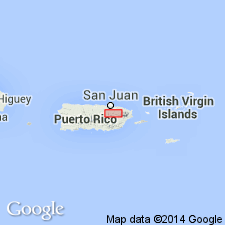
- Usage in publication:
-
- Cerro Gordo Lava*
- Modifications:
-
- Revised
- AAPG geologic province:
-
- Caribbean region
Summary:
The Cerro Gordo Formation of Lidiak (1965), here revised as Cerro Gordo Lava, consists of lava, flow breccia, and minor tuff and tuff breccia. Is very similar to the Lapa Lava Member of the Robles Formation. Contains a bedded tuff member, 180 m thick. Unconformably overlapped by younger Oligocene and Quaternary strata. Age is Early and Late Cretaceous based on age of Robles.
Source: GNU records (USGS DDS-6; Reston GNULEX).

- Usage in publication:
-
- Cerro Gordo Lava*
- Modifications:
-
- Overview
- AAPG geologic province:
-
- Caribbean region
Summary:
The Cerro Gordo Formation occurs in eastern Puerto Rico and consists of basaltic andesite lava, flow breccia, and minor tuff and tuff breccia. Maximum estimated thickness is 1100 meters. The Cerro Gordo is of Early(?) Cretaceous age.
Source: GNU records (USGS DDS-6; Reston GNULEX).
For more information, please contact Nancy Stamm, Geologic Names Committee Secretary.
Asterisk (*) indicates published by U.S. Geological Survey authors.
"No current usage" (†) implies that a name has been abandoned or has fallen into disuse. Former usage and, if known, replacement name given in parentheses ( ).
Slash (/) indicates name conflicts with nomenclatural guidelines (CSN, 1933; ACSN, 1961, 1970; NACSN, 1983, 2005, 2021). May be explained within brackets ([ ]).

